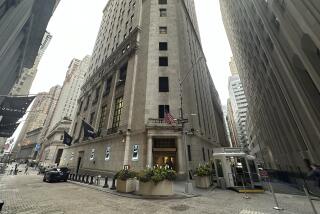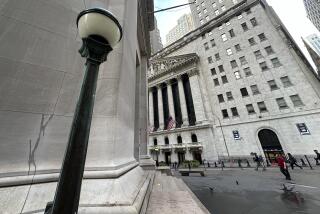The Dow: Shape of Things to Come?
The roar that you might have heard about midafternoon yesterday was most likely not a jetliner flying low, but the stock market breaking the 3,000 barrier.
For when the Dow Jones industrial average closed above 3,000 for the first time ever, people in the business of buying and selling let out a cheer. Like the groundhog acting as a harbinger of spring, a buoyant Dow is thought to be a sign of kinder, gentler things to come in the economy.
The Dow index--an average measure of the performance of 30 big-company stocks--is a key barometer of how much investors believe in the financial well-being of top American companies. It is not the only key and may not even be the best. But the very fact that the market closed above the magical three-grand mark should in itself send a warm glow through the economy.
Even if the Dow backslides today, as is entirely possible, the market seems to be hoping that the recovery from recession is just down the road. Clearly, investors are convinced that lower interest rates make stocks a better investment than the so-called “safer” bonds. That’s one major reason why investor money has been pushing up the Dow.
On the down side, there are still economic problems that could undermine investor confidence, not least among them the S&L; crisis and the possibility that major banks and insurance companies could face similar financial troubles in the near future. Let’s face it, as an economic seer, the Dow has probably been wrong as often as it’s been right.
So much depends on a reasonably rapid recovery. Unemployment is rising and output is slowing. The economy is stagnant in many sectors. Pessimism has been prevalent. The value of yesterday’s record-setting lies in the stock market’s reputation for anticipating future events. To a certain extent, things might get a little better because the market believes they will get better. The economy is the product of expectations and fears as well as of precisely measurable factors.
The hope of a recovery preoccupies political commentary worldwide as well as here at home. The recent cover story in The Economist--the influential London-based weekly--says flatly in its cover line: “There Will Be Growth in the Spring.” Inside, to be sure, the magazine hedges a bit: “Well, perhaps not in the spring, but in the summer anyway. By then the world economy will be picking up--not dramatically, not into some all-forgiving boom, but enough to confound the pessimists who felt, when last winter lay across the rich Northern Hemisphere, that economic permafrost was unavoidable.”
The Dow’s performance yesterday helped the optimists’ case.
More to Read
Inside the business of entertainment
The Wide Shot brings you news, analysis and insights on everything from streaming wars to production — and what it all means for the future.
You may occasionally receive promotional content from the Los Angeles Times.










